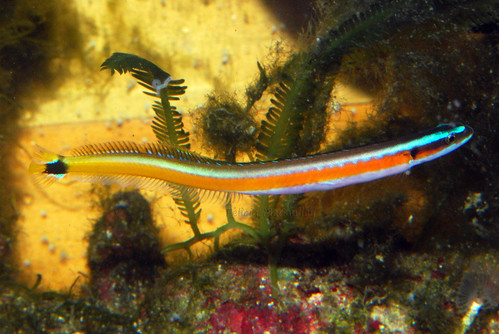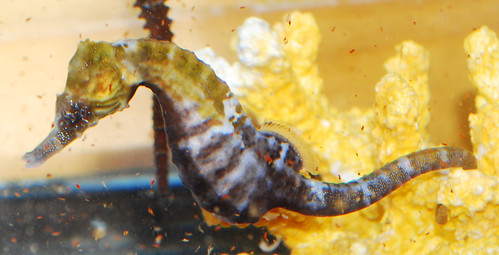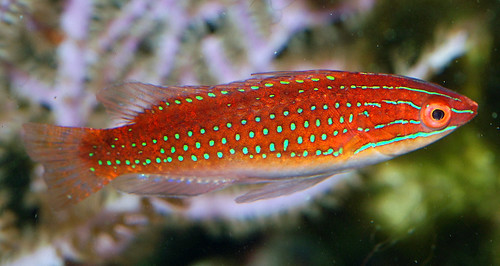
I've always been fascinated by livebearing fish like guppies, so when I discovered Brotulids, I had to know more about this odd, cryptic fish.
The most common species in the hobby is the yellow dusky Brotulid, otherwise known as a yellow eel goby. They're easy to care for and not picky eaters. They do best in small, peaceful aquariums with easily accessible places to hide, like PVC pipes and flowerpots. They should be target fed, since they are so shy. In large aquariums with a lot of rockwork, they can't be target fed and may starve.
I bought my first yellow dusky Brotulid in March 2008. I put him into my reef aquarium with over 90 pounds of live rock where he promptly dove under a rock pile never to be seen again. A few months later, I bought another one and put her in my seahorse aquarium which has low lighting and little live rock. She lives inside of a rock that is shaped like a cave. I can easily see her, but sometimes I have to use a small flashlight. She is almost constantly in movement, hovering inside her cave while undulating her beautiful, ribbon-like fins. She has become much less shy and even pokes most of the way out of her cave to eat thawed frozen mysis shrimp alongside my seahorses. She is not picky about what she eats and took to frozen food right away. She lives with my two female Orange Eel Gobies, which are a similar species. All three of them are very social with one another and share a cave. Strangely, they also share their cave with my Curious Wormfish, who is very similar to them in behavior and body shape. She is extremely peaceful and doesn't bother any of the small crustaceans or fish that share her tank. Even the squat lobster and Trimma gobies are safe with her.
 Sexing this species of Brotulid is a little different than sexing other species. The males of most Brotulid species have large, visible claspers at the beginning of the anal fin. The male yellow Brotulid has a fleshy, crescent shaped pouch which contains his rounded claspers and sexual organs. The female (pictured here) is similar to females of other species in that they have a tiny "knob" at the front of the anus. Breeding this species in captivity might prove to be as easy as breeding freshwater livebearers. The young are large and highly developed when they are born. Unfortunately, there isn't a high demand for this cryptic species, so aquaculture facilities are not breeding them. There have been reports from hobbyists that some Brotulids eat bristleworms, which are a nuisance to aquarists. If this claim can be validated, that would make this species more popular with hobbyists.
Sexing this species of Brotulid is a little different than sexing other species. The males of most Brotulid species have large, visible claspers at the beginning of the anal fin. The male yellow Brotulid has a fleshy, crescent shaped pouch which contains his rounded claspers and sexual organs. The female (pictured here) is similar to females of other species in that they have a tiny "knob" at the front of the anus. Breeding this species in captivity might prove to be as easy as breeding freshwater livebearers. The young are large and highly developed when they are born. Unfortunately, there isn't a high demand for this cryptic species, so aquaculture facilities are not breeding them. There have been reports from hobbyists that some Brotulids eat bristleworms, which are a nuisance to aquarists. If this claim can be validated, that would make this species more popular with hobbyists.These fish have gone by many scientific names including Dinematichthys riukiuensis, Brotulina fusca, and Diancistrus fuscus. No one is entirely sure which scientific name is valid for the little yellow Brotulids that sometimes show up in the aquarium trade. According to fishbase.org, Brotulina fusca is no longer a valid name, and is replaced by and a synonym of Diancistrus fuscus. Fishbase.org goes on to say that Brotulina fusca is very rare and known only from a single male specimen. It seems unlikely, but not impossible, to me that such a rare species would regularly make it into the aquarium trade. I think that these yellow Brotulids we see in the aquarium trade are more likely in the genus Dinematichthys. I recently came across this photo of a Dinematichthys randalli while doing a Google search. This is the closest I've ever come to positively identifiying my little Brotulid.
The best information I've found on these awesome fish so far has been from a German website called www.seahorsemania.eu. This is what they have to say (translated loosely into English):
"The following photos and info on the animal, comes courtesy of Martin Reith, Freiburg - www.seahorsemania.eu
This very unusual fish, Freiburg shop "Under Water" photographs, where several rare animals for sale. The Yellow bearded Brotulid is considered "Brotulina fusca" in the aquarium trade, but the current Latin name is Diancistrus fuscus. Hardly a rarity these aquarists will have ever seen, so a few additional details:
Assignment and kinship:
The Yellow bearded Brotulid is the family of livebearing Brotulas (Bythitidae) in order Ophidiiformes (like fish entrails / male-like beard) and is therefore associated with the widely-style cod (Gadiformes) related. Fishes of the order Ophidiiformes are mainly deep-water fish and this is also the reason why most divers and aquariums are not yet familiar with members of this order. The only members of this order, the little known, are the bizarre fish viscera (Family Carapidae) in the body of live sea cucumber.
In the family of livebearing Brotulas (Bythitidae) in addition to marine fish and a few representatives that live in anchialinen caves (caves where freshwater and saltwater mix). To mention are the genera Typhliasina, lucifuga and Ogilbia from cave systems in Central America as well as in various groups of islands in the western Atlantic and eastern Pacific. From the genus Diancistrus come here next to the imagined nature, even (still rare) reddish colored fish on the market. They are traded as Brotulina Erythrea, it could therefore possibly be Diancistrus erythraeus.
Verbreitung und Lebensraum:
The Yellow bearded Brotulid Diancistrus fuscus lives in the western Pacific in southern Japan, Taiwan and the northern half of the Philippines. To the south of the equator it is replaced by "Allen's bearded Brotulid" Diancistrus alleni. The Yellow bearded Brotulid was rarely observed free-living, it probably lived in shallow waters up to 20 meters in depth, well hidden in columns of coral reefs.
Posture and nutrition:
When it comes to attitude, we can only give rough recommendations because we have little experience with this species. For the welfare of the Yellow Bearded Brotulid in the aquarium, a large number of crevices and caves are needed, since the animals in nature predominantly reside in in columnar systems. Since the diet of these animals still as good as nothing is known, however, should first try to get these animals in a darkened aquarium with very little possibilities to keep hiding in order to be able to observe what food they take. The above-mentioned with the Yellow Beard related fish from anchialinen caves are known to eat several small crustaceans. Yellow Beard Brotulids may eat small copepods and Mysis shrimp. Pair or group housing would be recommended so that the very interesting reproductive behavior and the largely unknown social behavior can be observed.
Reproduction:
The animals are livebearing fish and have an internal fertilization. The males have in a belly fold a penis and pair of claspers similar to those of rays and sharks. The females live bring juveniles to the world. Perhaps Yellow Beard Brotulids are especially easy to breed.
Abstract:
The Yellow Bearded Brotulid is a rarely traded, and highly interesting from an unusual fish group, their way of life is still very little known. Even the exceptional reproduction suggests that the biologically interested aquarists, who is a Artbecken up a lot of sensational observations can be. The very hidden way of life make the Yellow Bearded Brotulid unsuitable for aquarium fish in their normal set, mixed reefs aquarists often want to see."
























